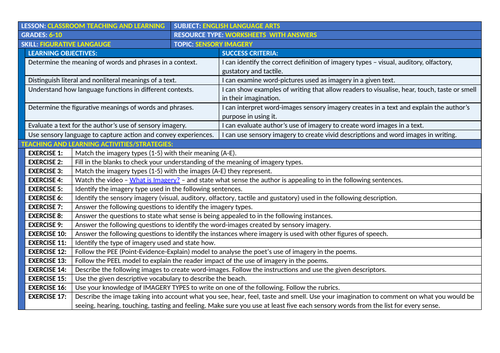








These Worksheets with Answers are perfect for teaching Sensory Imagery – Auditory, Visual, Olfactory, Gustatory and Tactile. These no prep activities would be great for ELA lessons or ELA centers. Your students will love these exercises that are carefully planned for student engagement.
This Download Includes:
EXERCISE 1: Match the imagery types (1-5) with their meaning (A-E).
EXERCISE 2: Fill in the blanks to check your understanding of the meaning of imagery types.
EXERCISE 3: Match the imagery types (1-5) with the images (A-E) they represent.
EXERCISE 4: Watch the video – What is Imagery? – and state what sense the author is appealing to in the following sentences.
EXERCISE 5: Identify the imagery type used in the following sentences.
EXERCISE 6: Identify the sensory imagery (visual, auditory, olfactory, tactile and gustatory) used in the following description.
EXERCISE 7: Answer the following questions to identify the imagery types.
EXERCISE 8: Answer the questions to state what sense is being appealed to in the following instances.
EXERCISE 9: Answer the following questions to identify the word-images created by sensory imagery.
EXERCISE 10: Answer the following questions to identify the instances where imagery is used with other figures of speech.
EXERCISE 11: Identify the type of imagery used and state how.
EXERCISE 12: Follow the PEE (Point-Evidence-Explain) model to analyse the poet’s use of imagery in the poems.
EXERCISE 13: Follow the PEEL model to explain the reader impact of the use of imagery in the poems.
EXERCISE 14: Describe the following images to create word-images. Follow the instructions and use the given descriptors.
EXERCISE 15: Use the given descriptive vocabulary to describe the beach.
EXERCISE 16: Use your knowledge of IMAGERY TYPES to write on one of the following. Follow the rubrics.
EXERCISE 17: Describe the image taking into account what you see, hear, feel, taste and smell. Use your imagination to comment on what you would be seeing, hearing, touching, tasting and feeling. Make sure you use at least five each sensory words from the list for every sense.
Get this resource as part of a bundle and save up to 50%
A bundle is a package of resources grouped together to teach a particular topic, or a series of lessons, in one place.
SENSORY IMAGERY: BUNDLE
These bundled resources are perfect for teaching Sensory Imagery – Auditory, Visual, Olfactory, Gustatory and Tactile. These no prep activities would be great for English lessons or English centers. Your students will love these ELA Boom Cards, Google Slides, PPT, Unit Plan and Worksheets. After completing this unit students will be able to: * Identify the correct definition of imagery types – visual, auditory, olfactory, gustatory and tactile. * Examine word-pictures used as imagery in a given text. * Show examples of writing that allow readers to visualise, hear, touch, taste or smell in their imagination. * Interpret word-images sensory imagery creates in a text and explain the author’s purpose in using it. * Evaluate author’s use of imagery to create word images in a text. * Use sensory imagery to create vivid descriptions and word images in writing. This download includes: * Boom Cards: 60 Digital Task Cards * Unit Lesson Plan: 18 Pages * Scaffolding Notes: 5 Handouts * Worksheets with Answers: 17 Exercises * PowerPoint Presentation: 19 Slides * Google Slides: 19 Slides Here are some possible uses for these in your classroom: * To challenge early finishers * For effective tutoring * As ESL stations and sub tubs * As holiday work and homework * For small group collaborations * For an end of unit assessments * For reinforcement and enrichment ◈◈◈◈◈◈◈◈◈◈◈◈◈◈◈◈◈◈◈◈◈◈◈◈◈◈◈ Save 50% on this BUNDLE! Note: These are also sold separately! ◈◈◈◈◈◈◈◈◈◈◈◈◈◈◈◈◈◈◈◈◈◈◈◈◈◈◈
FIGURATIVE LANGUAGE WORKSHEETS WITH ANSWERS BUNDLE
This bundle of 10 products (Worksheets with Answers) is perfect for teaching Figures of Speech - Simile, Metaphor, Hyperbole, Analogy, Personification, Sensory Imagery, Irony, Synecdoche, Metonymy, Alliteration, Onomatopoeia, Repetition, Rhyme and Idioms. These no prep activities would be great for ELA lessons or ELA centers. Your students will love these exercises that are planned for student engagement. After completing these lessons, the students will be able to: * Define various figures of speech with examples. * Compare and contrast various figures of speech. * Examine the examples of various figures of speech to identify their meaning. * Interpret a given text and identify the examples of various figures of speech. * Evaluate a text and explain how various figures of speech have impact on the reader. * Use figures of speech to make writing poetic and to express creatively and concisely. This bundle includes Worksheets on: * Rhetorical Comparison Devices: 23 Exercises * Rhetorical Sound Devices: 35 Exercises * Sensory Imagery – Word Images: 17 Exercises * Personification – Figure of Speech: 18 Exercises * Irony Types – Verbal, Situational, Dramatic: 20 Exercises * Synecdoche vs Metonymy: 27 Exercises * Oxymoron: 22 Exercises * Idioms: 15 Exercises * Elegy: 8 Exercises * Metaphor: 22 Exercises * Simile: 28 Exercises Here are some other possible uses for these in your classroom: * To challenge early finishers * For effective tutoring * As ESL stations and sub tubs * As holiday work and homework * For small group collaborations * For an end of unit assessments * For reinforcement and enrichment ◈◈◈◈◈◈◈◈◈◈◈◈◈◈◈◈◈◈◈ Save 50% on this BUNDLE! Note: These are also sold separately! ◈◈◈◈◈◈◈◈◈◈◈◈◈◈◈◈◈◈◈
Something went wrong, please try again later.
This resource hasn't been reviewed yet
To ensure quality for our reviews, only customers who have purchased this resource can review it
Report this resourceto let us know if it violates our terms and conditions.
Our customer service team will review your report and will be in touch.